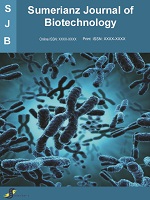Sumerianz Journal of Biotechnology

Online ISSN: 2617-3050
Print ISSN: 2617-3123
Quarterly Published (4 Issues Per Year)
Journal Website: https://www.sumerianz.com/?ic=journal-home&journal=32Archive
Volume 6 Issue 1 (2023)
The Antisickling Properties of Aristeus Antennatus Extracts in the Management of Sickle Cell Disease
Authors : Nwaoguikpe R. N. ; Obiekwe L. C. ; Emejulu A. A.
DOI : doi.org/10.47752/sjb.61.11.18
Abstract:The antisickling effect of dried Aristeus antennatus was investigated to ascertain the efficacy of the extract of the sample to inhibit polymerization of sickle cell haemoglobin (HbSS), and improve the Fe2+/Fe3+ ratio of sickle cell blood. The sample was first dried, ground into powder and soaked in chloroform to defat it in order to produce the fat soluble fraction (filtrate). The defatted residue was air-dried and later soaked in methanol for 24 hours to obtain the methanol soluble fraction. The fat soluble fractions (FAS) and methanol soluble fractions (MAS) were able to inhibit HbSS polymerization to varying degrees from 58% for FAS and 69% for MAS. Phytochemical analysis of the sample revealed the presence of proanthocyanin, quinine, saponin, isoflavone, spartein, phytate, cyanogenic glycoside, catechin, flavone, tannin, oxalate, alkaloids and others, at varying concentrations. Amino acid composition was determined for the sample using the amino acid analyzer (PTH), which revealed a preponderance of both essential and non-essential amino acids of which some were antisickling amino acids at varying concentrations. The identified amino acids include: Phenylalanine, Histidine, Leucine, Lysine, Tryptophan, Isoleucine, Valine, Methionine, Proline, Arginine, Tyrosine, Serine and others. However, the FAS and MAS fractions of the sample Aristeus antennatus extract improved Fe2+/Fe3+ ratio significantly. Aristeus antennatus extracts with the preponderance of micro and macro nutrients, vitamins, antioxidants, amino acids and others, may be very beneficial for the management of sickle cell disease.
Quantitative Determination of Oxalic and Phytic Acids of Lippia Multiflora Moldenke (Verbenaceae) Leaves and In Silico Study of Their Interaction with Haemoglobin S and 2,3-DPG-Mutase
Authors : Colette Masengo Ashande ; Koto-Te-Nyiwa Jean-Paul Ngbolua ; Néhémie Kwevi Masevo ; Jason Kilembe Thambwe ; Oscar Shetonde Mihigo ; Odette Kabena Ngandu ; Dorothée Tshilanda Dinangayi ; Damien Tshibangu Sha-Tshibey ; Guy Ilumbe Bayeli ; Pius Mpiana T
DOI : doi.org/10.47752/sjb.61.1.10
Abstract:The aim of this study is to measure oxalic and phytic acids from the leaves of Lippia multiflora and to evaluate their anti-sickle cell activity in silico. The histological characterization of the leaves of L. multiflora was performed by optical micrography. Theseanti-nutritional factors oxalic acid and phytic acid were determined by the standard method. Discovery Studio, ChemDraw and Autodock Vina software were used in molecular modeling. The pharmacokinetic and toxicological profile was evaluated using the bioinformatics descriptor SWISSADME. Histological analysis shows that fibres, sclerites and suber fragments are characteristic tissues of L. multiflora leaves. These leaves contain oxalic acid (insoluble oxalates: 51.457±27.653 mg/100 g DM; total oxalates: 59.483±0.704 mg/100 g MS; calcium oxalates: 0.216±0.0021 mg/100 g MS) and phytic acid (18.400±5.062 mg/100 g MS). Oxalic acid interacts more effectively with 2,3-diphospgoglycerate mutase (ΔG=-5.30±0.03 kcal/mol) while phytic acid interacts more strongly with deoxyhemoglobin S (ΔG=-9.30±0.01 kcal/mol) in silico. Phytic acid interacts with deoxyhemoglobin S by two hydrogen bonds (Arginine 31 and Lysine 120) while oxalic acid forms five hydrogen bonds with 2,3-DPG mutase (Arginine 10, Asparagine 17; Arginine 62; Histidine 188 and Glycine 189). The pharmacopharmacokinetic profile shows that these compounds do not inhibit cytochrome P450 complex enzymes and are not toxic. Both compounds represent added value for L. multiflora in the symptomatic treatment of sickle cell disease. In addition to attenuating hypersideremia, they can inhibit erythrocyte sickle formation via interaction with both protein receptors.



